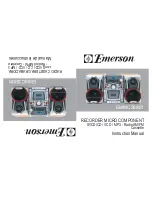
15
Owner’s Manual
Owner’
s Manual
EFFECTS: SERIAL OR PARALLEL?
“Serial” means that the entire channel signal
leaves the mixer (insert [12] send), is routed
through the effects device, and returns to the
mixer (insert return). Examples: compressor,
limiter, graphic equalizer. Line-level sources can also be
patched through a serial effects device before
connection to the mixer.
“Parallel” means that a portion of the signal in the
mixer is tapped off to the device, processed, and
returned to a spare channel of the mixer to be mixed
with the original “dry” signal. This way, multiple
channels can all make use of the same effects device.
Examples: reverb, digital delay. The internal effects
are parallel, as all channels can make use of it, and the
processed output is added to the main mix.
16. FX FOOTSWITCH
This 1/4" TRS connector is where you can connect a
footswitch. This will allow you to easily mute or un-mute
the internal effects, while stamping your foot and
looking like you were mad about something. Any
one-button on/off footswitch will work.
If the internal effects have already been muted with
the front panel mute switch [54] then the footswitch
has no effect, but you can still stamp your foot and pout
if that helps any. Cultivate that bad-boy image.
17. MON 1 SEND
This 1/4" TRS connector allows you to send the
monitor 1 line-level output to stage monitors. These
could either be passive stage monitors powered by an
external amplifier, or powered stage monitors with
their own amplifier built in.
The monitor signal is the sum (mix) of all the
channels whose mon 1 control [21] is set to more than
minimum. The overall output level can be adjusted with
the mon 1 master level [43] and its EQ tweaked with
the monitor graphic EQ [41].
The monitor 1 output is not affected by the main
master level [38], or the channel level controls [31].
This allows you to set up the monitor mix and level just
right, and not have it change every time a channel level
or the main mix level is adjusted. This is the main aim
of a monitor mix: independence from the main mix.
18. MAIN SUB
This 1/4" TRS connector supplies a copy of the mono
main mix below 100 Hz. This is usually patched to the
inputs of an external power amplifier running a passive
subwoofer, or directly to a powered subwoofer. Whatever
adjustments you make to the main mix, will affect this
output below 100 Hz.
(The main mix still plays the full frequency range,
this sub output is just a copy of the range below 100 Hz
for external subwoofers.)
19. MAIN OUTPUTS
These 1/4" TRS outputs supply the stereo main
mix at line-level. You can connect these outputs to the
line-level inputs of external power amplifiers running
passive loudspeakers, or to the inputs of powered loud-
speakers (or not use them at all, if you don't have the
external gear).
These outputs play the same signal as the rear-panel
speaker-level outputs [3] (when set to stereo mains),
only at line-level.
These outputs can also be used to feed an external
stereo effects processor or other device, and have the
processed output of that device feed the power amp
inputs [20]. This places the device in-line and it will
affect the main mix.
Another super idea is to use an external
active crossover. This splits the line-level main
output into two or three frequency bands. The
high-frequency output of the crossover could
be connected to the power amp inputs [20], so the
internal amplifiers will power your top-frequency-range
loudspeakers. The active crossover's low-frequency
outputs could connect directly to powered subwoofers.
In this way, you can take some of the strain off your
powered mixer's internal amplifiers, and have the
powered subwoofers crank out the bass.
20. POWER AMP INPUTS
These unbalanced 1/4" TS inputs allow you to connect
line-level signals directly to the input of the internal
power amplifiers.
The amplifiers will only play what you put in, and only
the precision passive EQ switch [47] and limiters [48]
will affect the output. The power amp mode switch [4]
has no effect, and the meters will not show the levels.
Plugging anything in here, does not affect any of the
line-level outputs.
You could patch a device between the main outputs
[19] and these inputs, in which case, the controls and
meters will work except for the power amp mode switch.
These inputs are also useful when you need more
channels then the PPM1008 provides. You could
connect the line-level outputs from another mixer,
and use it to control the mix and levels playing in loud-
speakers attached to the powered mixer.
The external mixer or device will control
the volume, so turn it down at first, or the
powered mixer may come on at full volume.
















































